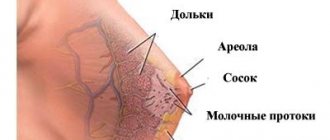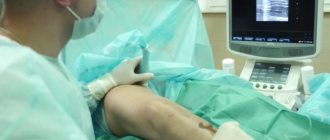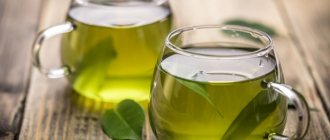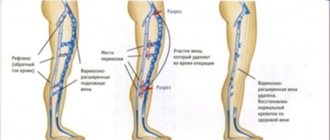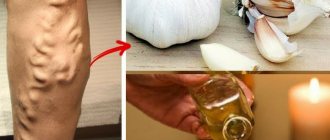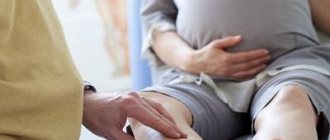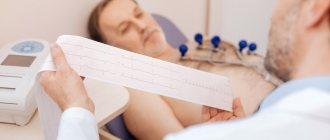Ointments for the treatment of varicose veins have different effects on the body due to the components included in the composition. Let's take a closer look at what active ingredients are found in popular ointments and what benefits they bring to the body.
Heparin - affects blood clotting. Accelerates the dissolution of microthrombi in subcutaneous capillaries, thereby slowing down the process of blood clot formation. Inhibits the decomposition of hyaluronic acid in the body and helps connective tissue recover. Essential phospholipids reduce blood viscosity. Escin - increases the tone of veins, reduces capillary fragility, inhibits inflammation.
These three components are included in the composition of gels against varicose veins. Relieves pain, swelling, heaviness and fatigue in the legs. They should be used to get rid of the symptoms of the disease in the early stages or as an addition to treatment in the later stages.
Products containing extract from red grape leaves increase the elasticity of blood vessels. Do not allow plasma, proteins and water to penetrate from the vessel into the tissue. They help with swelling, fatigue and tension in the legs, and relieve pain. Recommended for relieving symptoms of varicose veins or for prevention.
Products containing an extract from the mucous membrane of the small intestine of animals reduce the level of a protein involved in the formation of blood clots. The drug thins the blood, reduces the risk of blood clots, and prevents swelling. Good results from use are achieved in combination with compression garments.
Horse chestnut seed extract increases vein tone, reduces inflammation and vascular permeability. Relieves swelling, a feeling of heaviness and fatigue in the legs, itching and pain.
What are venotonics
Venotonics or they are called phlebotonics, venoprotectors
are medicines that can tone the veins, improve the quality of the walls of blood vessels, properly distribute lymph and establish lymph flow and blood flow, “adjust the quality of details” of our body in order to prevent or get rid of the development of dangerous consequences - blood clots and thrombosis . Venotonics are presented very widely on pharmacy shelves and each of the drugs has a varying degree of effectiveness, but one common pharmacological effect is increased muscle tone on the walls of blood vessels and an effect on capillary permeability. Taking venotonic drugs is a key point in the successful treatment of varicose veins. While taking the drugs, there is a decrease in unpleasant symptoms in the lower extremities, pain, swelling, and heaviness.
Questions from patients from the Internet:
How effective is ointment for veins and blood vessels on the legs?
The effectiveness of ointments and gels for the treatment of varicose veins has been greatly exaggerated. In other words, ointment for veins and blood vessels on the legs is nothing more than a marketing ploy that has little correspondence with reality.
Horsepower gel for veins, what are the real reviews from doctors?
You are unlikely to find real reviews from doctors and phlebologists who practice modern treatment of varicose veins about the horsepower gel. Various ointments and gels in the treatment of vein pathology are really used as maintenance therapy, nothing more.
Does heparin ointment for legs really help against varicose veins and fatigue?
Heparin ointment is indeed used in the complex treatment of pathology of the veins of the lower extremities by many leading phlebologists, including specialists from our phlebology center. When used correctly, this ointment helps eliminate symptoms of heaviness and fatigue in the legs. However, no ointment can somehow affect either varicose veins or the main symptoms of chronic venous insufficiency.
Do you use ointments and gels for varicose veins and thrombophlebitis of the lower extremities in your practice?
The specialists of our phlebology center actually use ointments and gels in the complex treatment of varicose veins and its complications, thrombophlebitis. In this situation, ointments and gels are not the main treatment, but only additional local therapy for the symptoms of varicose veins and thrombophlebitis of the lower extremities.
When are venotonics prescribed?
Venotonics should be taken from the first signs of vascular problems. Under favorable conditions, that is, when varicose veins are at the zero stage, but unpleasant symptoms such as swelling and heaviness already appear, venoprotectors can prevent the severe consequences of varicose veins and minimize consequences such as thrombosis, thrombophlebitis, and trophic changes.
The earliest stage is the case when it is important to take a comprehensive approach to treatment and “hear” your body.
At later stages, it is recommended to coordinate medications and especially the dosage with your doctor.
Myth No. 2: varicose veins can be cured with ointments and gels. This is wrong.
I still can’t understand how exactly varicose veins can be defeated with the help of ointments and gels. In one famous television advertisement, a girl applies ointment to her varicose veins and, lo and behold, they disappear before our eyes. Any patient would give anything in the world for such a miraculous ointment.
How can these ointments heal a damaged valve?
Rubbing the gels into the skin of the lower extremities is just a light massage of the legs, and has a calming effect on a person, and the menthol content also cools them. This is the psycho-emotional factor.
Another important point is the allergic component, which appears in some patients during the use of ointments and gels. Skin irritation - allergic dermatitis, is not so rare. This can even worsen the condition of the lower extremities. And using ointments in the presence of trophic changes is possible only after consulting a dermatologist.
Allergic dermatitis after using venotonic gel
The pharmacy may recommend you natural ointments based on horse chestnut, heparin-containing gels, or the very extravagant Sophia cream with leech extract, which has nothing to do with leeches or varicose veins. But patients, using these creams, ointments, gels, tell me during the consultation: “but it really helps me.” If it helps you, use these remedies. But I consider this self-hypnosis and a waste of money.
How to diagnose varicose veins
- Using functional tests (application of a tourniquet), the condition of the valves is studied. They are named after the authors - Troyanov-Trendelenburg, Pratt, Sheinis, Delbe-Perthes, etc.. For the Troyanov-Trendelenburg test, you need to lay the patient horizontally, then offer to raise the leg 450. In this position, the doctor strokes the limb from the foot upward to empty the superficial veins. The next step is to apply a tourniquet to the upper half of the thigh, after which the patient rises from the couch. Healthy veins in the legs should fill up after 15 seconds.
- Duplex ultrasound scanning of veins (ultrasound angioscanning) provides the most information and allows you to visualize the vessels and blood flow through them.
- Dopplerography is a method for assessing blood circulation through vessels.
- Phlebography or X-ray examination using contrast, which helps to study the internal structure of the vessel.
- Phleboscintigraphy is a technique using radioactive substances with further study on a special device for their distribution.
To study the superficial veins, they are examined and palpated. The first three methods are used as additional examinations. The last two methods are necessary to study the condition of the deep or deep veins.
Using ointment for spider veins on the legs
The use of ointments or tablets will not work on spider veins. To remove stars on the legs, sclerotherapy is used - a method in which a drug is injected into the vessel to glue the veins together, causing them to stop expanding. For varicose veins, this method also works and is used when it is impossible to use other types of surgical treatment.
Sclerotherapy is more like a cosmetic procedure. Traces after surgery completely disappear over time. The procedure is painless. Local anesthetic may be used individually at the request of the patient. After the operation, the patient goes home.
How can varicose veins be complicated?
- Thrombosis due to blood stagnation.
- Vascular thromboembolism as a result of blood clot detachment.
- Thrombophlebitis or inflammation of the venous wall.
- PE (pulmonary embolism). In this case, blood flow in the pulmonary circulation is sharply disrupted, which leads to death. Small blood clots can lodge in the small pulmonary arteries and cause a heart attack or pulmonary edema.
- Trophic ulcers, eczema on the skin of the legs due to tissue malnutrition. With poor blood circulation, little oxygen and nutrients enter the tissues, which impairs regeneration or causes massive cell necrosis.
- Edema syndrome. As a result of impaired blood outflow and stagnation, fluid leaks through the walls of blood vessels into the intercellular space. The swelling is soft in consistency, elastic, and most often appears near the affected vein, regardless of the time of day.
- Dermatitis. The inflammatory process in the skin develops due to impaired blood flow and tissue nutrition.
- Hyperpigmentation, cyanosis of the affected areas of the skin.
- Consolidation of subcutaneous fat due to swelling and hemorrhage.
Benefits of Professional Treatment
You cannot self-medicate with ointments for varicose veins alone. In this case, there is a risk of aggravating the disease, and then surgery cannot be avoided. To choose an effective treatment strategy, it is best to consult a phlebologist. The doctor will examine you and send you for examination. Only after this will he make a diagnosis, on the basis of which a course of treatment will be prescribed.
The Medicenter network of clinics employs experienced phlebologists and functional diagnostics doctors who use the latest methods for treating varicose veins: both surgical and non-surgical.
Surgery is not scary
For the treatment of varicose veins the following are used:
- phlebectomy - surgical removal of varicose veins, when they are pulled out through a small incision in the skin,
- laser and radiofrequency surgery are also surgical treatment methods that, unlike traditional surgery, do not require incisions, are performed under local anesthesia and have no physical limitations.
Surgical methods for treating varicose veins and spider veins are the most effective today. Laser and radiofrequency treatments are more often used. They are less traumatic and do not require a rehabilitation process. After the operation, the patient is recommended to take a half-hour walk.
Why you shouldn’t be afraid of treating varicose veins with surgical methods, read more in the article “Varicose veins: should you be afraid of surgery to remove veins?”
Which brand of ointment for varicose veins is better to choose?
Any pharmacy chain has analogues and identical medications, differing only in country, brand, and price. You can judge their quality and effectiveness in absentia by the reputation of the manufacturer. The best ointments for varicose veins, which were recognized by experts as leaders in 2021, were offered by the following pharmaceutical companies:
- Nizhpharm (Heparin ointment) is a Soviet pharmaceutical company in Russia that was created in Nizhny Novgorod back in 1919. Today it is one of the largest manufacturers of medicines. The product portfolio includes over 30 pharmacological groups, 100 names.
- CJSC "Green Dubrava" (Vishnevsky Ointment) is a full-cycle enterprise offering both substances and finished medicines. The company was officially registered in 2003, when it moved from Sergiev Posad to the city of Dmitrov. It is at the development stage and has 4 large workshops.
- Balkanpharma (Troxevasin) is a Bulgarian pharmaceutical company that was founded in 1999. Today it is part of the international holding Actavis. It uses the latest technologies according to European standards, producing medicines for the treatment of people and animals.
- Hemofarm (Gepatrombin) is an international pharmaceutical company that was founded in Serbia in 1960. Since 2006, it has been privatized by the German concern STADA AG. Today it is the largest exporter, as well as a leading player in the domestic pharmaceutical market.
- A. _ Menarini Manufacturing Logistics and Services (Lioton) is an Italian pharmaceutical company founded in 1915. Engaged in the development, production, processing, production of drugs for humans, as well as in veterinary medicine. Medicines from this brand are very popular on the Russian market.
- Sandoz (Venitan) is an international pharmaceutical company that was founded in Switzerland back in 1886. It deals with biosimilars and generics, that is, reproduction of the most popular medicines patented by other companies. This name is trusted by medical professionals today.
- Merckle GmbH (Dolobene) is a well-known German company that produces highly effective medicines. It was founded in 1881, first in the Czech Republic and Slovakia. It was moved to Germany in 1945. Her activities concern all areas of medicine.
- Elfa, Farmzavod, A.T. (Flucinar) is a group of companies that was founded in Poland about 20 years ago. Today it is the largest Polish manufacturer of ointments, as well as the main supplier of hormonal, cardiological, psychotropic and other groups of medicines. Production fully complies with GMP requirements.
- OJSC Akrikhin (Venolife) is a chemical and pharmaceutical plant in Russia, one of the leaders in the production of high-quality, affordable drugs. It is one of the five largest local pharmaceutical manufacturers in terms of production and sales volume.
- JSC Sopharma (Indomethacin) is a Bulgarian pharmaceutical company that was founded in 1993. Engaged in the development of medicinal, hygiene, and cosmetic products. Since 2007, she joined JSC “Bulgarian Rose-Sevtopolis” in order to expand its activities.
For what reasons does varicose veins appear, and who is at risk of getting sick?
It is difficult to say why people get varicose veins at the moment. Only a number of risk factors have been identified, due to which the valves weaken and the elasticity and tone of the walls of the superficial and perforating veins decrease.
Here are the factors that lead to the development of the disease:
- Heredity. The structure of the walls of blood vessels is determined genetically; with some changes in the genes, they weaken and the valves do not close well. As a result, with the slightest increase in pressure in the veins, a reverse outflow of blood occurs, the vessels overflow and expand.
- Hormonal changes in the body in women. This situation is typical for pregnant women or for the second half of the cycle, when the amount of progesterone increases and the level of estrogen decreases. As a result, blood rheology changes (coagulability increases), vascular tone decreases, elastin and collagen fibers are destroyed, and the risk of blood clots increases.
- Obesity. People who are overweight move little, which slows down blood flow throughout the body. Excess subcutaneous fat on the abdomen leads to increased pressure in the abdominal cavity and compression of the main veins. This leads to stagnation of blood in the vessels of the legs, and further to varicose veins.
- Diabetes. Sugar, the level of which increases in this disease, damages the vascular endothelium, which increases the risk of blood clots.
- Alcoholism. When drinking large doses of alcohol, dehydration occurs, the blood thickens, clots form, clogging small blood vessels and causing congestion.
- Static occupational loads, such as lifting heavy loads, standing or sitting work. In such a situation, muscle tone drops, blood moves worse from the lower extremities to the heart, stagnation occurs, and the veins in the legs dilate because of this.
- Congenital pathologies of blood clotting. Hypercoagulation, in which too many factors are produced that are responsible for the formation of clots in the blood, provokes thrombosis and impedes the movement of blood through the vessels.
- Wrong diet. A diet deficient in a number of vitamins (C, E, PP) and plant fiber leads to disturbances in the structure of the endothelium and other structural elements of the vascular walls.
- Tight underwear. When wearing tight underwear, some of the veins are pinched, which causes obstructed blood flow from the lower half of the body.
- Frequent constipation. People suffering from this problem have to constantly push, this increases the pressure inside the abdomen, as a result, the outflow of blood becomes difficult.
- High heel. Overstraining the calf muscles and insufficient contraction causes blood to stagnate in the veins.
- Hot climate. In summer, during the heat, the body becomes dehydrated. If you do not compensate for the problem by drinking a sufficient volume of fluid, the risk of blood clots in the vessels will increase.
- Pathologies of the heart and kidneys. These may be congenital or acquired heart defects, renal failure.
- Exceeding doses of medications that affect coagulation. In this case, the blood vessels may become clogged with blood clots.
- Operation. The risk of thrombosis in this case increases due to blood loss and compression of veins during the intervention.
